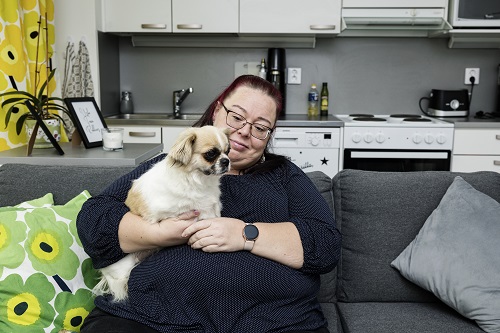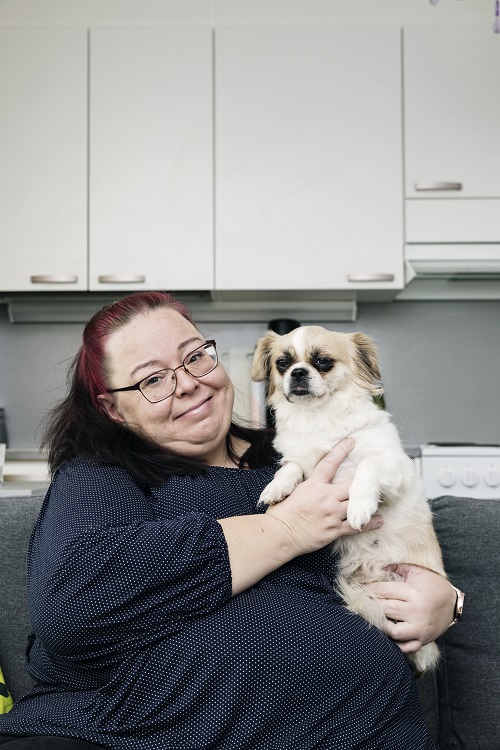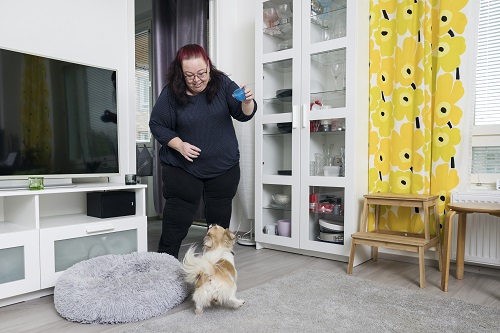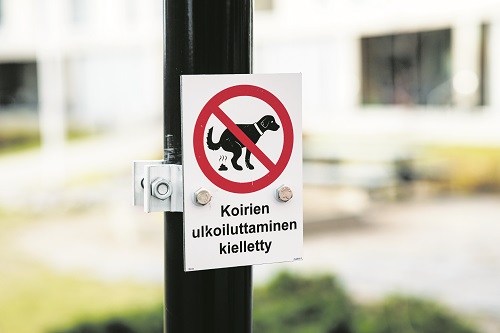A barking dog can put neighbourliness to the test – separation anxiety-ridden dog Aida found a new home next door
Pets are welcome at Heka! Pets and neighbours usually enjoy a problem-free coexistence, and any difficult situations are resolved together. For Aida the dog, the solution was to move next door.

There are an estimated 800,000 pet dogs in Finland. It is no wonder then that there is also a significant number of pet dogs living in the families and as neighbours of Heka tenants. Pets are allowed at all Heka locations. Sari Lindfors lives on Tullivuorentie in Malmi together with her Tibetan spaniel Maisa. According to Lindfors, the eight-year-old Maisa is beloved throughout the neighbourhood and frequently played with and taken on walks by the local children and also petted by adults.
Lindfors and Maisa moved to Tullivuorentie in January 2023 together with the family’s other Tibetan spaniel, 13-year-old Aida. The move was not easy for Aida, who started to suffer from severe separation anxiety in the new apartment every time the family members stepped out.
“Aida would cry and bark, and we tried all kinds of different solutions, but nothing worked,” Lindfors says.
Lindfors has extensive experience with dogs, and before the Tibetan spaniels, her family included a Labrador retriever. In the past, she had not had any problems living with dogs.
After Aida’s loud anxiety had continued for over a month, Lindfors found an anonymous note slipped into her letterbox from a neighbour who was tired of the noise. Lindfors wanted to discuss the inconvenience caused by Aida with the neighbour, so she set out to determine who had left the note. She rang her neighbours’ doorbells and asked people in the yard whether her dog’s barking had disturbed them.
Eventually she found the neighbour who had left the note, but the situation proved difficult and they could not establish a dialogue.
“There was so much disagreement that I also contacted the property manager,” Lindfors says.
The best way to tell things is to tell them directly
Joint custody with a neighbour works
It is only natural for dogs to bark from time to time, but according to the rules of conduct of Heka buildings, owners must ensure that their pets do not disturb others with repeated barking. However, the owner of a noisy dog may be completely unaware that their pet is being a nuisance, which is why the issue should always be reported to the owner directly. Treating separation anxiety can take time, so sometimes neighbours need to be patient.
Heka Property Manager Jari Rutanen is not familiar with Aida’s case, but has dealt with other similar situations. Rutanen says that if there are any complaints about a dog barking or other pet behaviour, the aim is to always resolve the matter through dialogue and restore peace to the building. According to him, such complaints are very rare.
“I have been working for Heka for just under two years and only received one or two complaints about pets in that time. In these cases, the owners were understanding and took action once they were informed about the issue. Everything went well, and the issues were resolved and discussed with tenants,” Rutanen says.
“Sometimes there have been challenges related to people teaching puppies, but overall pets have not caused any major disturbances,” Rutanen continues.
In the case of Aida the dog, the solution was found surprisingly close by: Lindfors got acquainted with a mother and daughter living in the neighbouring building who became very fond of Aida. In the summer, they took Aida in to live with them.
“I first met this lady at the building committee’s spring event. She immediately fell in love with Aida, who is a bit of a therapy dog. Now we have joint custody – sometimes Aida comes to stay with us and at other times they take care of Maisa,” Lindfors says.
According to Lindfors, the current arrangement has satisfied all parties. She is particularly happy to have found a home for Aida so nearby.

Tenants are responsible for their pets’ behaviour indoors and outside
The owner is always responsible for the behaviour of their pet. If a pet constantly disturbs other tenants, the matter will be discussed with the owner and, if necessary, the owner will be issued a notice. If the issue is not resolved despite several notices, the owner will be issued a warning. In blatant cases, a warning can be issued directly without a notice. Such blatant cases would include a cat repeatedly peeing in the playground sandbox, for example.
At Heka locations, pets cannot be kept off the lead in stairways or yard areas or walked in or near children’s playgrounds. Pets also have no business being in saunas or laundry rooms. Furthermore, it is important for owners to immediately remove any pet droppings from the property area.
Inside apartments, it is also advisable to keep an eye on pets so that they do not damage the apartment.
“The tenant is responsible for covering the cost of repairing any scuffs or damage that cannot be considered the result of normal wear and tear. Such damage would include animal bite marks on door frames,” Rutanen points out.
In order to ensure the safety of cats or other pets and to prevent them from running away, tenants are allowed to install lightweight netting designed for this purpose on their balconies, provided that it does not need to be permanently attached to the balcony structure. According to Rutanen, however, the netting must not be ‘disruptive’ in its appearance due to being excessively prominent or high, for example.

“If you let one dog pee in the yard, you will soon have ten others doing the same”
Lindfors proposes that more signs be put up at buildings and their yards to ensure that the rules are clear to everyone.
“We have a yard here that is shared between Heka and owner-occupied houses. I would like it to be clear to everyone that you cannot have dogs pee in the yard, for example: If you let one dog pee in there, you will soon have ten others doing the same. In my opinion, this is about everyone’s living comfort,” Lindfors says.
Instead of the yard area, Lindfors and Maisa take walks and meet other dogs and their owners at a nearby dog park.
“The dog park is very important. We have a date there almost every day with Aida and her current owner,” Lindfors says.

Neighbourliness put to the test? Direct contact and discussion work the best
For Lindfors, placing Aida the dog in her neighbour’s family has worked well and become a permanent solution.
“When we tried to take Aida back a few times, Maisa clearly got a little scared of her. Aida is so strong-willed – she’s our boss, whereas Maisa is a bit of a softie,” Lindfors says.
If the dogs disturb other tenants in the future, Lindfors would like to be contacted about it directly.
“In my opinion, it is best to be direct. After all, I can’t do anything about it if I don’t know about it. Or if you decide to leave a note, at least don’t do it anonymously,” Lindfors says.
Property Manager Rutanen also stresses the importance of open discussion and notes that following the rules of conduct goes a long way, regardless of whether you have pets.
“Of course the rules of conduct must be followed, but any problems have always been resolved cooperatively. Animal owners are smart people,” Rutanen praises.
Keep your pet safe during celebrations as well
A home can also be a dangerous place for a pet, which is why it is important to keep any dangerous objects out of your pet’s reach. In addition to sharp kitchen utensils and tools, things that can be dangerous to animals include unprotected electric wires and small items that pose a chocking hazard, such as earbuds and Christmas decorations.
Especially during Christmas, it is important to keep in mind that chocolate is poisonous to dogs. Christmas roses and any other houseplants that are poisonous to pets should also be placed out of their reach.
Pets must also be protected from stressful stimuli, such as noise. New Year fireworks cause anxiety in many dogs – and cats. A pet that is sensitive to noise should never be left alone during fireworks, nor should you take it with you outside to watch the fireworks. Things that can calm down a fearful pet include a peaceful environment, a safe place and the presence of the owner.
Sources: TassuApu, Huoneistokeskus, Plantagen
